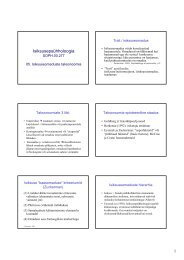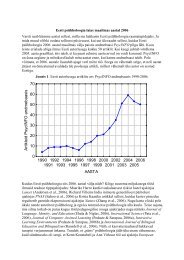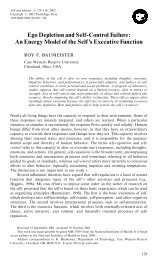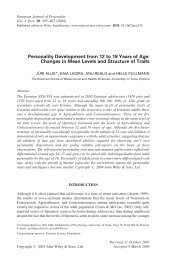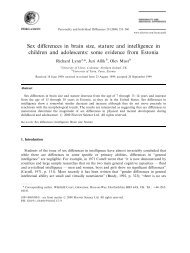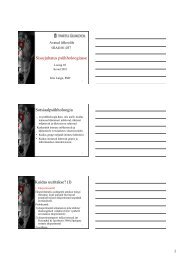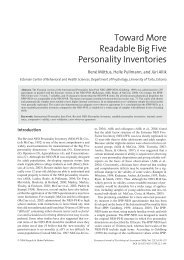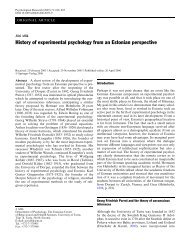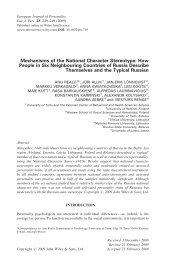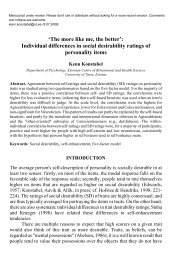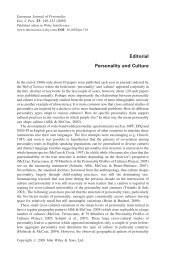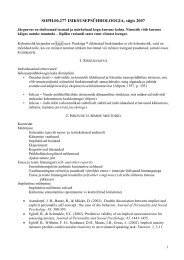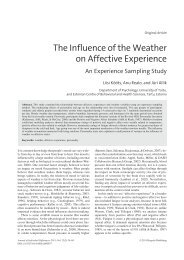Economic inequality is linked to biased self-perception
Economic inequality is linked to biased self-perception
Economic inequality is linked to biased self-perception
Create successful ePaper yourself
Turn your PDF publications into a flip-book with our unique Google optimized e-Paper software.
1256 Loughnan et al.<br />
Nations Human Development Report (United Nations Human<br />
Development Programme, 2010).<br />
Results<br />
Data were analyzed using multilevel modeling. Two-level<br />
multilevel regression models (with traits nested in persons)<br />
were estimated <strong>to</strong> obtain an average and separate random<br />
intercept and slope value for each nation. Three-level models<br />
(with traits nested in persons nested in nations) were estimated<br />
<strong>to</strong> examine the moderating role of income <strong>inequality</strong> and individual<strong>is</strong>m/collectiv<strong>is</strong>m<br />
in <strong>self</strong>-enhancement. Both age and<br />
gender significantly moderated <strong>self</strong>-enhancement (age: b =<br />
0.003, p = .044; gender: b = –0.05, p < .001), and thus, all<br />
subsequent analyses controlled for these fac<strong>to</strong>rs. Since 72 participants<br />
failed <strong>to</strong> report age or gender, the <strong>to</strong>tal number of<br />
participants was reduced <strong>to</strong> 1,553 individuals.<br />
Self-enhancement was measured by regressing <strong>self</strong>-ratings<br />
on<strong>to</strong> trait desirability. Th<strong>is</strong> approach allows for individual and<br />
cultural differences independent of the relationship between<br />
<strong>self</strong>-ratings and desirability of traits. If people <strong>self</strong>-enhance,<br />
they should rate desirable qualities as especially <strong>self</strong>-descriptive<br />
relative <strong>to</strong> the average person (Guenther & Alicke, 2010). In a<br />
two-level model predicting <strong>self</strong>-report from trait desirability<br />
and controlling for age and gender at the person level, a significant<br />
<strong>self</strong>-enhancement effect was found across nations using<br />
dummy-coded variables for each nation at the person level<br />
(b = 0.24, p < .001). Further, a significant <strong>self</strong>-enhancement<br />
effect was found within every nation (all ps < .022). Cons<strong>is</strong>tent<br />
with the findings of prior research, our results showed that<br />
there was considerable variability between nations (bs =<br />
0.07–0.42).<br />
Next, national Gini coefficients were included at the nation<br />
level in a three-level model. As income <strong>inequality</strong> increased,<br />
people’s tendency <strong>to</strong> <strong>self</strong>-enhance also increased (b = 0.01, p =<br />
.002). Next, we included individual<strong>is</strong>m/collectiv<strong>is</strong>m alongside<br />
the Gini coefficients. In th<strong>is</strong> model, income <strong>inequality</strong><br />
remained a significant predic<strong>to</strong>r of <strong>self</strong>-enhancement (b =<br />
0.01, p = .001), and individual<strong>is</strong>m did not significantly predict<br />
levels of <strong>self</strong>-enhancement above income <strong>inequality</strong> (b <<br />
–0.001, p = .331). Moreover, Gini coefficients were significantly<br />
better predic<strong>to</strong>rs of <strong>self</strong>-enhancement than individual<strong>is</strong>m<br />
and collectiv<strong>is</strong>m were, χ 2 (1) = 25.40, p < .001. A model with<br />
Gini coefficient and individual<strong>is</strong>m/collectiv<strong>is</strong>m performed<br />
better than a model with individual<strong>is</strong>m/collectiv<strong>is</strong>m only,<br />
χ 2 (2) = 15.94, p < .001. By contrast, adding individual<strong>is</strong>m/<br />
collectiv<strong>is</strong>m <strong>to</strong> a model containing only Gini coefficients did<br />
not result in a significant improvement, χ 2 (2) = 0.05, p > .500.<br />
These results indicate that, in th<strong>is</strong> sample, income <strong>inequality</strong><br />
was more important for explaining cross-national differences<br />
in levels of <strong>self</strong>-enhancement than individual<strong>is</strong>m/collectiv<strong>is</strong>m<br />
were. For example, in comparing Venezuelans (high collectiv<strong>is</strong>m,<br />
high income <strong>inequality</strong>) with Japanese (high collectiv<strong>is</strong>m,<br />
low income <strong>inequality</strong>) in a two-level model with dummycoded<br />
nation variables, the former showed much higher levels<br />
of <strong>self</strong>-enhancement than did the latter (b = 0.40 vs. b = 0.07,<br />
respectively).<br />
We also investigated the influence of another cultural variable,<br />
power d<strong>is</strong>tance, which may be more closely <strong>linked</strong> <strong>to</strong><br />
economic <strong>inequality</strong> than individual<strong>is</strong>m and collectiv<strong>is</strong>m are. 1<br />
Power d<strong>is</strong>tance captures the extent <strong>to</strong> which people prefer<br />
an au<strong>to</strong>cratic hierarchy versus a relative equality of power<br />
(Hofstede, 2001). When power-d<strong>is</strong>tance scores were included<br />
in the three-level model, Gini coefficients remained significant<br />
predic<strong>to</strong>rs of <strong>self</strong>-enhancement (b = 0.01, p = .001), but<br />
individual<strong>is</strong>m/collectiv<strong>is</strong>m (b < 0.001, p = 0.513) and power<br />
d<strong>is</strong>tance (b < 0.001, p = .986) did not.<br />
There was a significant positive relationship between Gini<br />
coefficients and <strong>self</strong>-enhancement at the national level, r(15) =<br />
.79, p < .001. As expected, people see themselves as superior<br />
<strong>to</strong> others <strong>to</strong> a greater extent in societies with a higher level of<br />
income <strong>inequality</strong> (Fig. 1). To investigate whether the observed<br />
positive prediction of <strong>self</strong>-rating by trait desirability reflected<br />
the belief that the <strong>self</strong> was indeed better than others, we<br />
selected the 20 most desirable traits in each nation. We then<br />
conducted a single-sample t test for each nation <strong>to</strong> test whether<br />
the mean <strong>self</strong>-rating score for the 20 most desirable traits differed<br />
from the scale midpoint of 4 (which was labeled as neither<br />
less nor more than the average student/person). In 14 of<br />
the 15 nations, the average <strong>self</strong>-rating was indeed significantly<br />
higher than the scale midpoint for these desirable traits (all<br />
ps < .01). Only Japanese participants failed <strong>to</strong> rate these traits<br />
significantly above the scale midpoint, t(19) = 1.36, p = .19,<br />
although the mean was in the anticipated direction (M = 4.12).<br />
In short, people typically viewed themselves as better than<br />
average.<br />
D<strong>is</strong>cussion<br />
The tendency for people <strong>to</strong> believe they possess more desirable<br />
character<strong>is</strong>tics than others appears widespread. It was observed<br />
in 15 nations spanning all developed continents. It <strong>is</strong> important<br />
<strong>to</strong> note that the magnitude of th<strong>is</strong> <strong>self</strong>-enhancing bias varied<br />
according <strong>to</strong> societal differences in economic <strong>inequality</strong>. In<br />
societies with less income <strong>inequality</strong>, people showed a relatively<br />
weak bias compared with people in societies with more<br />
income <strong>inequality</strong>. It appears that people in societies with more<br />
income <strong>inequality</strong> tend <strong>to</strong> view themselves as superior <strong>to</strong> others,<br />
and people in societies with less income <strong>inequality</strong> tend <strong>to</strong> see<br />
themselves as more similar <strong>to</strong> their peers.<br />
Socioeconomic differences accounted for the variability in<br />
th<strong>is</strong> bias better than did individual<strong>is</strong>m/collectiv<strong>is</strong>m, the cultural<br />
dimensions that have guided most previous research.<br />
Th<strong>is</strong> finding does not invalidate the utility of individual<strong>is</strong>m/<br />
collectiv<strong>is</strong>m for thinking about cultural differences. Indeed,<br />
these dimensions capture many East-West differences in <strong>self</strong>and<br />
other <strong>perception</strong>, including <strong>self</strong>-enhancement (for recent<br />
reviews, see Heine & Hamamura, 2007; Kitayama & Uskul,<br />
2011; Oyserman & Lee, 2008). Our research emphasizes<br />
the importance of considering material differences between<br />
Downloaded from pss.sagepub.com at Tartu Ulikooli Raamatukogu on Oc<strong>to</strong>ber 30, 2011



